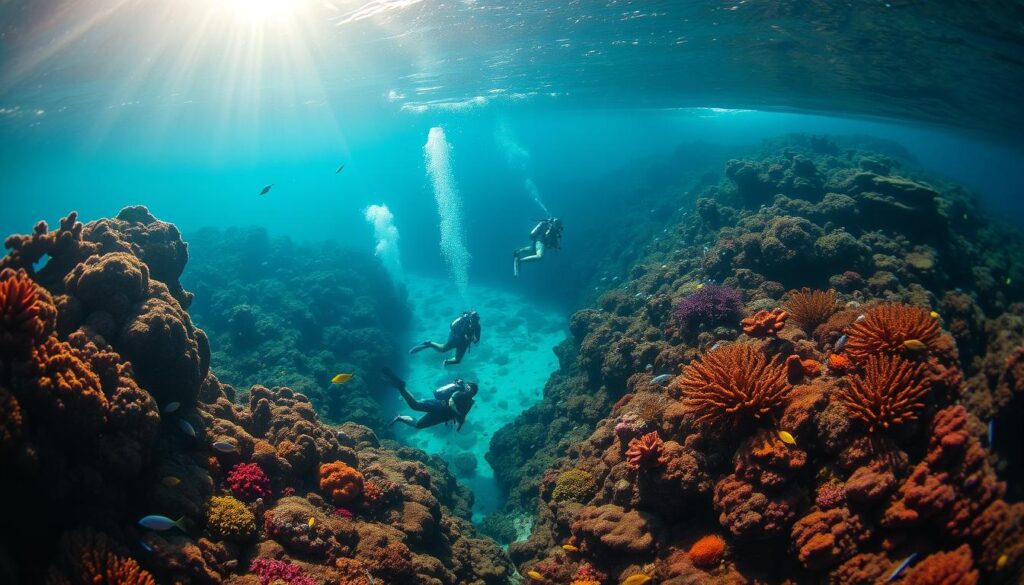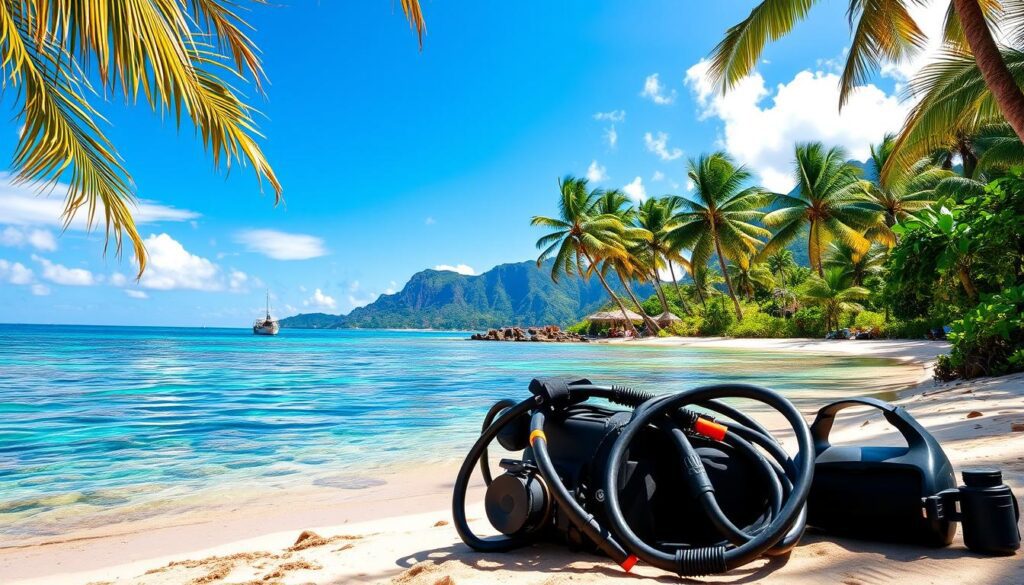Diving in Hawaii is a top-tier experience in the Americas, with famous spots like Maui and Kona on the Big Island. Molokini Crater and the thrilling manta ray night dive are just the beginning. Hawaii caters to all divers, from beginners to the seasoned. Its underwater world is teeming with life, featuring turtles, manta rays, humpback whales, reef sharks, and eagle rays.
Hawaii’s unique geography and diverse ocean environments offer a wide range of scuba diving opportunities. From shore diving to exploring lava tubes, there’s something for everyone. Whether you’re into vibrant coral reefs, elusive marine creatures, or the region’s rich cultural heritage, Hawaii’s scuba diving spots promise an unforgettable journey.
Key Takeaways
- Hawaii is a premier scuba diving destination in the Americas with famous spots like Maui and Kona
- The Hawaiian Islands offer a diverse range of scuba diving experiences, from shore diving to encounters with larger marine life
- Beginner divers can explore depths of up to 12 meters (40 feet) without formal training
- Hawaii is home to a rich and diverse marine ecosystem, including turtles, manta rays, humpback whales, reef sharks, and eagle rays
- Scuba diving in Hawaii provides an opportunity to discover vibrant coral reefs, lava tubes, and the region’s cultural heritage
Diving in Hawaii: A Paradise for Underwater Explorers
The Hawaiian Archipelago is a true scuba diving paradise, offering a diverse array of underwater adventures. With around 750 miles (1,210 kilometers) of coastline, Hawaii boasts an abundance of tropical waters teeming with rich marine life. From diving in the crater of a volcano to night dives with manta rays, the islands present a wide range of exciting experiences suitable for divers of all skill levels.
Tropical Waters and Rich Marine Life
Hawaii’s warm, clear waters are home to a remarkable variety of marine species, including over 1,200 species of fish, many of which are endemic to the region. Divers can expect to encounter a stunning array of coral reefs, sea turtles, sharks, and even the occasional humpback whale during the winter months. With more than 20% of Hawaii’s marine life being endemic, the underwater world offers a truly unique and immersive experience.
Diverse Diving Experiences for All Levels
Whether you’re a beginner or an experienced diver, Hawaii has something to offer. The islands provide a range of diving options, from shallow shore dives to deeper boat dives, catering to all skill levels. Divers can explore shipwrecks, caverns, and even an extinct volcano crater, each offering its own set of thrilling encounters. With water temperatures ranging from 74 to 80 degrees Fahrenheit year-round, the diving conditions are comfortable and inviting.
The best time to go scuba diving in Hawaii is often from April to November, when the weather and water conditions are most favorable. With its diverse marine life, stunning underwater landscapes, and a wide variety of diving experiences, Hawaii truly is a scuba diving paradise for underwater explorers.
Oahu: The Wreck Capital of Hawaii
Oahu, the third-largest island in Hawaii, is known as the “Wreck Capital of Hawaii.” It boasts a variety of wreck diving sites, attracting scuba enthusiasts. With over ten wrecks around the island, Oahu offers a unique chance to explore sunken treasures and underwater ecosystems.
Exploring Sunken Treasures like the Corsair Wreck
The Corsair Airplane Wreck, which sank in 1946, is one of Oahu’s most famous wrecks. It lies at a depth of 107 feet, allowing certified divers to see this historic aircraft up close. Other notable wrecks include the Landing Craft Utility (LCU) Wreck at 85 feet, the New Barge at around 100 feet, and the Baby Barge, with a maximum depth of 85 feet and an intriguing cavern.
Shark Cage Diving Adventures
Oahu also offers unique shark cage diving experiences. Divers can see various shark species, including Galapagos, sandbar, and tiger sharks. They might also spot blue, silky, or hammerhead sharks from the safety of a shark cage. These encounters offer a thrilling way to observe these magnificent creatures in their natural habitat.
Oahu’s diverse diving options, from captivating wreck sites to adrenaline-pumping shark cage adventures, make it a scuba diving paradise. Whether you’re an experienced wreck diver or seeking an unforgettable underwater experience, Oahu’s “Wreck Capital” status promises an unforgettable adventure.
Kona: Manta Ray Heaven
Kona, on the Big Island, is famous for its scuba diving spots, but one stands out – the chance to see manta rays. These gentle giants, with their massive wingspans, attract divers and snorkelers to the Kona coast.
Unforgettable Night Dives with Manta Rays
The most sought-after manta ray experience in Kona is the night dive at Manta Ray Heaven, also known as Garden Eel Cove. Located just offshore from the Kona International Airport, it’s one of three manta ray viewing spots on the Big Island. It’s the top choice for both divers and snorkelers. With dozens of these pelagic wonders gliding through the water, lit up by underwater lights, the night dive at Manta Ray Heaven is unforgettable.
Blackwater Diving: A Surreal Experience
Kona also offers a unique diving experience – blackwater diving. During this nighttime dive, divers see a variety of larval-stage marine creatures rising to the surface. This creates a surreal and otherworldly display. From tiny shrimp to bizarre fish larvae, the blackwater dive in Kona is a unique adventure for the brave underwater explorer.
Whether you’re captivated by the manta rays or the mysteries of blackwater diving, Kona’s underwater world is a paradise for scuba enthusiasts. With its diverse diving experiences and stunning marine life, this Hawaiian destination is a must-visit for any diver seeking an unforgettable adventure.
Maui and Molokini: A Unique Conservation District
Maui is a true underwater paradise, offering scuba divers a wealth of exciting adventures. Besides the famous Molokini Crater, the island boasts several captivating wreck dives. The St Anthony and the Carthaginian were purposely sunk to create artificial reefs. Now, these reefs are teeming with vibrant schools of colorful reef fish.
The Iconic Molokini Crater Dive
Just 30 minutes by boat from Maui’s shores, the Molokini Crater is a semi-submerged volcanic formation. It’s a designated Marine Life Conservation District. This unique ecosystem is home to over 200 species of fish, many of which are endemic to Hawaii. It also has a thriving population of Wedge-tailed Shearwaters and Bulwer’s Petrels nesting in the crater’s rocky cliffs.
Molokini offers exceptional visibility, often exceeding 150 feet, due to the absence of sediment in the water. The calm inner lagoon provides an ideal environment for snorkelers and beginner divers. Meanwhile, the outer reef presents a more challenging experience for experienced scuba enthusiasts. The best conditions for exploring Molokini occur from May to September, though tours operate year-round.
Preserving the fragile environment of Molokini is of utmost importance. Responsible, sustainable tour companies play a crucial role in maintaining the integrity of this unique conservation area. By choosing eco-conscious operators, visitors can enjoy the wonders of Maui’s Molokini scuba diving while contributing to the protection of this Hawaii conservation area.
Hawaii scuba diving spots: Lanai’s Underwater Wonders
Lanai, a hidden gem among Hawaii’s islands, offers a unique underwater adventure. The Cathedral I and Cathedral II dive sites are highlights, showcasing the island’s stunning cave and cavern systems.
Cathedral I & Cathedral II: Caves and Caverns
Lanai’s Cathedral I and Cathedral II are celebrated for their clear waters and rich marine life. These sites, with their large, cathedral-like chambers, are among Hawaii’s top scuba diving spots. Divers can explore the nutrient-rich terrain through vaulted arches.
Upon entering these caverns, divers encounter a variety of marine life. They see vibrant tropical fish, graceful eagle rays, and sometimes sharks or turtles. The caves’ geological beauty and the marine life create an unforgettable experience for scuba enthusiasts.
Whether you’re a seasoned Lanai scuba diving pro or new to Hawaii cave diving and Hawaii cavern diving, these sites are a must-see. They offer a unique chance to dive into the wonders of the Hawaiian archipelago.
Molokai: Spectacular Drift Dives

Molokai, the fifth-largest island in Hawaii, is renowned for its spectacular drift diving experiences. Its pristine reef systems house a variety of dive sites, with most being drift dives. This unique experience allows divers to spot elusive pelagic species, such as the Hawaiian monk seal or hammerhead sharks. They also encounter an abundance of smaller fish life and rare marine creatures.
The Hole in the Wall is a famous drift dive site in Molokai. It ranges in depth from 100 feet to just 40 feet from the surface, with visibility often between 80 and 100 feet. Due to its swift current, it’s recommended for expert divers only. Another popular spot is the Fish Rain site, where divers can see hammerheads, whale sharks, and even tiger sharks at depths of up to 100 feet.
The Cove offers a more serene drift diving experience. It ranges in depth from 20 to 100 feet, providing a chance to see unique marine life like lemon butterfly fish and porcupine puffers. Given Molokai’s small and quiet nature, it’s crucial to book dive charters well in advance to secure your spot on these spectacular drift diving adventures.
Molokai’s drift dives are a true marvel, with approximately 23% of Hawaii’s fish species found here. Whether you’re an experienced diver or new to the sport, these dives promise to amaze you. They offer a glimpse into the island’s diverse marine ecosystems and the elusive creatures that call them home.
Kauai: Sea Turtles Galore
Kauai, the northernmost island in Hawaii, is a hotspot for scuba diving. It’s especially famous for its encounters with Hawaiian green sea turtles. Dive sites like Sheraton Caverns and Turtle Bluffs are known for their reliable turtle sightings. These gentle creatures often ignore divers and their cameras.
Sheraton Caverns and Turtle Bluffs
Sheraton Caverns and Turtle Bluffs are top spots for diving in Kauai. They offer a chance to see green sea turtles up close. Sheraton Caverns, with depths from 20 to 65 feet, is home to a variety of marine life. Turtle Bluffs, with depths from 40 to 95 feet, is known for its majestic spotted knifejaw fish and sea turtles.
Whale Watching Opportunities
Kauai’s waters are perfect for whale watching, even for divers. Divers might hear the haunting songs of humpback whales. The island’s unique landscapes, like collapsed lava tubes, add to its underwater beauty. This makes Kauai a must-visit for scuba diving enthusiasts.
| Dive Site | Depth Range | Key Marine Life |
|---|---|---|
| Sheraton Caverns | 20-65 ft | Sea turtles, sponge crabs, bicolor anthias |
| Turtle Bluffs | 40-95 ft | Sea turtles, spotted knifejaw |
| Koloa Landing | 20-60 ft | Sea turtles, eels, unique reef fish |
| Radio Tower | 25-50 ft | Sea turtles |
Kauai’s scuba diving scene is unmatched for experiencing Hawaii’s marine life. From the captivating Sheraton Caverns and Turtle Bluffs to hearing humpback whales, Kauai is a true underwater paradise. It’s a haven for scuba enthusiasts to observe sea turtles and whales in their natural habitat.
Best Time for Scuba Diving in Hawaii
Scuba diving in Hawaii is a year-round activity, thanks to the tropical climate and pleasant water temperatures. These temperatures peak in September. The best time to dive is from April to November, when it’s less crowded. Water temperatures range from 75-80°F (24-27°C) all year, but visibility can change with rainfall and runoff. It usually ranges from 75-100 ft (25-30m).
The peak diving season is from December to March, especially around Christmas and New Year. This time offers calmer waters and better visibility. Yet, it’s also the busiest and most expensive period. The low season, from April to mid-June and September to mid-December, is more affordable and less crowded. It has the same water temperatures and often better visibility.
| Season | Water Temperature | Visibility | Crowds | Cost |
|---|---|---|---|---|
| Peak (Dec-Mar) | 75-80°F (24-27°C) | 75-100 ft (25-30m) | High | High |
| Low (Apr-Jun, Sep-Dec) | 75-80°F (24-27°C) | 75-100 ft (25-30m) | Low | Low |
| Summer (Jun-Aug) | 75-80°F (24-27°C) | 75-100 ft (25-30m) | Moderate | Moderate |
Scuba diving in Hawaii is available all year. However, the best time for optimal conditions, fewer crowds, and lower prices is during the low season. This includes April to June and September to November.
Diving Conditions in Hawaii
Scuba diving in Hawaii offers an unparalleled underwater adventure, catering to both novice and experienced divers. With consistently favorable water temperatures and exceptional visibility, the island state provides a true tropical diving paradise.
Water Temperature and Visibility
The waters surrounding Hawaii maintain a comfortable temperature range throughout the year. During the summer months, the average water temperature hovers around 83°F (28°C), while in the winter, it dips slightly to a still-balmy 76°F (24°C). This allows divers to explore the vibrant marine life without the need for bulky, insulating wetsuits. Additionally, visibility in Hawaii’s waters is typically excellent, spanning 60 to 100 feet (18 to 30 meters), with the west coast of the Big Island generally less impacted by storms and afternoon showers.
Depth Range and Diving Difficulty
- Depth Range: Scuba diving in Hawaii is suitable for all levels, with a depth range of 10 to 130 feet (3 to 40 meters).
- Diving Difficulty: The state offers a diverse range of diving experiences, from beginner-friendly shallow reefs to more challenging drift dives and wreck explorations.
| Diving Condition | Hawaii Average |
|---|---|
| Water Temperature | Summer: 83°F (28°C), Winter: 76°F (24°C) |
| Visibility | 60 – 100 feet (18 – 30 meters) |
| Depth Range | 10 – 130 feet (3 – 40 meters) |
Overall, Hawaii’s diving conditions provide an exceptional underwater experience for adventurers of all skill levels. It is a premier destination for scuba diving and snorkeling enthusiasts alike.
Getting to Hawaii for Scuba Diving Adventures

Starting your scuba diving journey in Hawaii involves reaching the islands. Honolulu’s Daniel K. Inouye International Airport (HNL) on Oahu serves as the primary entry point. Other airports like Kahului Airport (OGG) on Maui, Ellison Onizuka Kona International Airport (KOA) on the Big Island, and Lihue Airport (LIH) on Kauai also welcome international flights. Domestic flights and inter-island ferries make it easy to travel between the islands once you arrive.
Flights from the mainland U.S. are often the most cost-effective way to get to Hawaii. They take around 6 hours from the West Coast. For those from Europe or other international locations, connecting through the U.S. or Japan is common before reaching Hawaii.
- Hawaii is an island chain of 137 islands, spanning 1,500 miles across the central Pacific Ocean.
- It’s the only U.S. state outside North America.
- Flight from LA to Hawaii: 6 hours, shorter than other Pacific diving destinations requiring 22+ hours.
| Airport | Location | Airport Code |
|---|---|---|
| Daniel K. Inouye International Airport | Honolulu, Oahu | HNL |
| Kahului Airport | Maui | OGG |
| Ellison Onizuka Kona International Airport | Big Island | KOA |
| Lihue Airport | Kauai | LIH |
With a variety of flights and transportation options, reaching Hawaii for a scuba diving adventure is easier than ever. Whether you’re diving the Kona Coast, exploring Molokini Crater, or discovering Kauai’s underwater wonders, the islands offer endless opportunities. Dive into the stunning marine environments and make memories that last a lifetime.
Scuba Diving Operators and Resorts in Hawaii
Scuba diving in Hawaii is a resort-based experience, offering a wide range of accommodation options to suit all budgets. Dive operators in the islands generally provide equipment rental and small group diving experiences. Costs range from $120 to $150 for a 2-tank dive. Some of the top-rated scuba diving operators in Hawaii include Big Island Divers, Jack’s Diving Locker, and Kona Diving Company.
Kona Honu Divers, located on the Big Island, boasts over 200 years of combined industry experience. It has been rated as Hawaii’s top-rated and most-reviewed dive company. The company emphasizes safety, maintenance, and experience. Their well-appointed and well-maintained boats provide a comfortable and stylish diving experience.
On the island of Oahu, Banzai Divers Hawaii is the highest-rated diving company. It offers personalized experiences by booking small groups for a more intimate dive. The experienced staff conducts tours in the safest manner possible. They aim to help divers leave with a newfound passion for the ocean.

Scott Sweeney is the creator of Virtual Hawaii 360. Scott is a professional marketer and a lifelong Hawaii enthusiast. Scott splits time between Oahu and Dayton, Ohio. In addition to his marketing endevours, he is also a published Ukulele musician.
